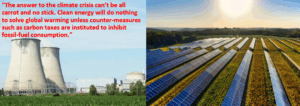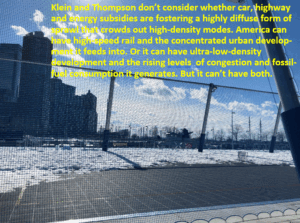Since the dawn of the Bill Clinton era over 30 years ago, no journalist has more incisively illuminated the confines of U.S. liberal centrism than Daniel Lazare. In books like The Frozen Republic and The Velvet Coup as well as countless articles in Jacobin, New Left Review and other outlets, Dan has plumbed America’s deep-seated Constitutional paralysis and exposed the futility of combating carbon pollution without pricing fossil fuels’ climate damage into their market price.
The best-selling book Abundance was perfectly tailored for Dan’s scalpel, and his review last month for the Union of Radical Political Economists (URPE) does not disappoint. Rather than a polemic, Dan’s review gives Abundance its due — “In their effort to reduce environmental harms, greens have wound up hobbling production in such a way as to … undermine efforts to deal with the climate crisis in an effective and comprehensive way.” Yet as he points out, “The disease is intolerable, and so is the cure” of making polluters pay through carbon taxes.
Dan’s review from URPE is reproduced below in its entirety, with permission. The graphics are ours. Dan currently publishes at Substack.
Book Review: Ezra Klein & Derek Thompson, Abundance.
Inside Ezra Klein and Derek Thompson’s rather pallid bestseller is a vigorous Marxist polemic trying to get out. Abundance begins with a quote from Aaron Bastani’s Fully Automated Luxury Communism (Verso, 2019) and ends with one from the Communist Manifesto: “The bourgeoisie, during its rule of scarce one hundred years, has created more massive and more colossal productive forces than have all preceding generations together.” Together, they serve to bookend the authors’ argument that in their effort to reduce environmental harms, greens have wound up hobbling production in such a way as to exacerbate inequality and homelessness and undermine efforts to deal with the climate crisis in an effective and comprehensive way.

Dan’s books uncannily foretold today’s multiple crises.
Despite protests from Robert Kuttner, co-founder of The American Prospect, and other outraged liberals, the argument carries weight. From a Marxist perspective, the reasons are clear. Liberal environmentalism is an ideology of just saying no, i.e. just say no to dangerous toxins in the water supply, to filling the atmosphere with noxious fumes, to scattering trash along highways and byways, and so forth. NIMBYism adds a further fillip that if you’re going to engage in such activities or do anything else that might disturb the environmental equilibrium, even if it’s for a good cause, don’t do it here. Since there is nothing that doesn’t disturb the environment in one way or another, the result is a stand-pat philosophy whose purpose is to preserve the status quo. Zeroing in on southern California, Klein and Thompson neatly sum up the prevailing ethos: “When do Angelenos want affordable housing? Now! Where do they want it? Not here!” The problem is that anything resembling a positive program, a way of organizing production so that it doesn’t harm the environment and in fact may even improve it, is absent.
The answer to the climate crisis is the polluter-pays principle.
The reason for this is clear as well. The answer to the climate crisis, the environmental crisis, and all the rest is to require capitalist production to bear the full cost. If a gallon of gasoline generates x amount of pollution and carbon emissions, not to mention expenditures for highway maintenance, noise abatement, and emergency services, then the simplest and most elegant solution is to incorporate the cost of x into the price of gas so that producers are forced to deal with the full consequences of their actions.
This is what’s known as PPP – the polluter-pays principle. But it’s impractical, which is to say incompatible with capitalist production, because it would wipe out profits. What would happen to the US auto industry if society were to recognize that the true cost of gasoline is not $4 or $5 a gallon, but $15, $20, or more? What would the results be for the “drill, baby, drill” crowd in both Texas and the Middle East if structurally-induced fossil-fuel consumption were to cease? Tolerance of environmental harms is a form of subsidy since it requires the state to cover costs that producers generate. Society pays them, in effect, to pollute. The long-term consequences are proving fatal as the climate crisis accelerates. Yet the short-term consequences of de-subsidization would prove fatal to bourgeois liberalism.
So bourgeois society dithers and dawdles, as Abundance describes. “In 2022, ninety countries and territories experienced often violent protests over the rising price of fuel,” Klein and Thompson recount. Subsidies must therefore continue. They quote a political scientist named Erik Voeten who notes that “people who bear the cost of climate policies increasingly flock to the far right.” So nothing can be done in terms of climate mitigation for fear of furthering rightwing polarization. The authors quote a pair of legal academics named J.B. Ruhl and James Salzman who note that property owners do not cotton to the prospect of oil pipelines or electric transmission lines running through their backyard. But “[g]uess what,” Ruhl and Salzman add, “they do not like the idea of wind turbines or solar panels in their backyard either.” Since they don’t like the problem or the solution, nothing can be done. The disease is intolerable, and so is the cure.
Abundance is highly effective in depicting how this policy snarl plays out. “In much of San Francisco,” Klein and Thompson write, “you can’t walk twenty feet without seeing a multicolored sign declaring that Black Lives Matter, Kindness Is Everything, and No Human Being Is Illegal. Those signs sit in yards zoned for single families, in communities that organize against efforts to add the new homes that would bring those values closer to reality.” San Francisco’s black population has fallen steadily since 1970 due at least in part to restrictions that force poor people in general into longer and longer commutes, if not outright homelessness.
The middle class is hypocritical, something that “progressives” would know if they ever read Flaubert, Sinclair Lewis, John Dos Passos, or Ring Lardner (which they don’t). California “is dominated by Democrats, but many of the people Democrats claim to care about most can’t afford to live there,” Abundance declares. Last year, “voters [who] were most exposed to the day-to-day realities of liberal governance” demonstrated their displeasure by casting ballots for the Republicans. “Nearly every county in California moved toward Trump, with Los Angeles County shifting eleven points toward the GOP.”
Liberalism has sown the seeds of its own destruction.
It’s a case of liberalism sowing the seeds of its own destruction. Abundance is particularly scathing on California’s great misadventure with high-speed rail. This is the project that Governor Jerry Brown initiated in 1982 with visions of bullet trains whizzing back and forth between San Francisco and Los Angeles. After all, if Japan can do it, why not the United States? Fourteen years later, the state formed a high-speed rail authority, and in 2008 voters authorized $33 billion. That was more than a quarter of a century of doing zilch, but Californians were assured that the first segment would go on line by the year 2020. In 2009, Barack Obama offered a full-throated endorsement:
“Imagine boarding a train in the center of a city. No racing to an airport and across a terminal, no delays, no sitting on the tarmac, no lost luggage, no taking off your shoes. Imagine whisking through towns at speeds over one hundred miles an hour, walking only a few steps to public transportation, and ending up just blocks from your destination. Imagine what a great project that would be to rebuild America.”
Except that do-nothing-ism continued until the project finally collapsed. “Let’s be real,” Gavin Newsom announced in 2019. “The project, as currently planned, would cost too much and take too long. There’s been little oversight and not enough transparency. Right now, there simply isn’t a path to get from Sacramento to San Diego, let alone from San Francisco to LA. I wish there were.”
 An astonishing $33 billion had gone down the drain. But why? Klein and Thompson describe how the project immediately bogged down in innumerable negotiations over property rights. “Negotiating with courts, with funders, with business owners, with homeowners, with farm owners,” they write. “Those negotiations cost time, which costs money. Those negotiations lead to changes in the route or the build or the design, which costs money.” State officials relied on expensive consultants who made matters worse: “It was one of these consultants – WSP – that estimated the system would cost only $33 billion and take only twelve years to build. But WSP was joined by Project Finance Advisory, Cambridge Systematics, Arup, TYLin, HNTB, PGH Wong Engineering, Harris & Associates, Arcadis, STV, Sener, and Parsons Corporation.” The Los Angeles Times concluded that outsourcing “proved to be a foundational error in the project’s execution – a miscalculation that has resulted in the California High-Speed Rail Authority being overly reliant on a network of high-cost consultants who have consistently underestimated the difficulty of the task.”
An astonishing $33 billion had gone down the drain. But why? Klein and Thompson describe how the project immediately bogged down in innumerable negotiations over property rights. “Negotiating with courts, with funders, with business owners, with homeowners, with farm owners,” they write. “Those negotiations cost time, which costs money. Those negotiations lead to changes in the route or the build or the design, which costs money.” State officials relied on expensive consultants who made matters worse: “It was one of these consultants – WSP – that estimated the system would cost only $33 billion and take only twelve years to build. But WSP was joined by Project Finance Advisory, Cambridge Systematics, Arup, TYLin, HNTB, PGH Wong Engineering, Harris & Associates, Arcadis, STV, Sener, and Parsons Corporation.” The Los Angeles Times concluded that outsourcing “proved to be a foundational error in the project’s execution – a miscalculation that has resulted in the California High-Speed Rail Authority being overly reliant on a network of high-cost consultants who have consistently underestimated the difficulty of the task.”
California officials who had no idea how to proceed relied on high-priced consultants who didn’t know either. It’s an example of a liberal polity that knows how to say no and nothing else. It knows what it shouldn’t do, but not what it should.
Klein and Thompson deserve credit for bringing all this out. But Abundance suffers from numerous analytical shortcomings. The authors tiptoe around difficult political problems and take refuge in fatuous techno-optimism. “[T]he only way for humanity to limit climate change while fighting poverty is to invent our way to clean energy that is plentiful and cheap and then spend enough to deploy it,” they assure their readers. “…One of the most devilish challenges in energy is how to efficiently remove CO2 from the atmosphere. By 2050, the world will need to permanently remove 10 billion tons of carbon dioxide from the skies every year to avoid the most catastrophic effects of climate change.” They open with a sci-fi vision in which future Americans drink desalinated sea water, consume lab-grown chicken and beef, get packages delivered by flying drones, and dash from New York to London in just over two hours in supersonic jetliners using low-carbon “green synthetic fuels.”
All of which is either puerile or misconceived. By itself, clean energy will do nothing to solve global warming unless counter-measures such as carbon taxes are instituted to inhibit fossil-fuel consumption. The answer to the climate crisis can’t be all carrot and no stick, but must include measures aimed at fostering conservation and energy efficiency. Carbon removal is a non-starter since it invariably requires more energy than it’s worth, while desalination is beside the point in a state like California in which there is so much waste that growers use 1,900 gallons of heavily-subsidized water to produce a pound of almonds despite a deepening drought. As for lab meat, it’s hard to imagine it being more energy efficient than raising chickens and rabbits the old-fashioned way on farms or in large-scale factories. It’s equally hard to imagine flying drones replacing delivery people on bikes in communities that are compact and car-free. Tech has its place, but real energy savings begin with such low-tech modes as walking and cycling.
As for supersonic air transport, fuhgeddaboudit. Air France and British Airways retired the Concorde in 2003 not only because one had crashed in Gonesse, France, killing 113 people, but because it was a gas-guzzler that used 3.8 times as much fuel as a modern wide-body airliner while carrying substantially fewer people. Green synthetic fuels will do nothing to eliminate that disparity.
Klein and Thompson are plainly on the side of more. But more of what, exactly? More CO2-spewing SUV’s?
But there’s more. Not only is Abundance awash with meaningless techno-optimism, but it’s silent on the political issues that are the real barriers to progress. Take consumerism. Klein and Thompson are plainly on the side of more, as is any labor organizer fighting for higher wages. But more of what, exactly? More CO2-spewing SUV’s? More highways so immobilized by traffic that they turn into elongated parking lots? More strip malls and gated communities? The problem with more in a period of capitalist decay is that it often translates into less, which is to say less mobility, less attractive surroundings, and less freedom to bike, walk, or engage in other modest pleasures due to dangerous levels of traffic. In describing rail advocates engaged in painstaking negotiations over rights of way, the authors don’t consider whether car, highway, and energy subsidies are fostering a highly diffuse form of sprawl that crowds out high-density modes. America can have high-speed rail and the concentrated urban development it feeds into. Or it can have ultra-low-density development and the rising levels of congestion and fossil-fuel consumption it generates. But it can’t have both. It’s a conundrum that Klein and Thompson resolutely avoid confronting, no doubt because it would make Abundance less user-friendly.
Then there’s the matter of class. Abundance is about middle-class consumers struggling to protect their way of life in ways that are increasingly counterproductive. But it makes no mention of the top one percent – really, the top 0.1 percent or even 0.01 – who are the real agents of destruction. Where are the oil barons who don’t care about the climate crisis as long as profits continue to grow? What about super-rich petro-sheiks – how did America wind up in alliance with such a motley crew? And what about the 40,000 US troops in and around the Persian Gulf? What are they doing there and whose interests are they serving? For anyone truly interested in American dysfunctionality, these are the places to start. Yet Klein and Thompson steer clear of such questions because they make people uncomfortable. And if there’s one thing we know about the publishing business, it’s that people don’t buy books that make them uncomfortable.
Finally, there is no sense of America as a society in an acute political crisis. Since Abundance was released in March, it evidently went to press before Trump was elected and therefore can’t be held responsible for failing to anticipate the full nature of the breakdown that is now before us. Still, it’s not as if there weren’t plenty of warnings as gridlock intensified and politics descended into game playing and threats. Government was in decay, yet no one could think of a way out.
 Abundance reflects this growing pessimism, but never asks why. It quotes a University of Chicago economist named Chad Syverson on a construction-industry regulatory process that is complicated beyond reason. “There are a million veto points,” he complains. Yet there’s no sense that the problem involves not just economic regulation, but a legislative process that also contains a million veto points thanks to hundreds of congressional committees and subcommittees, outrageous filibuster rules, a “hold” system that allows individual senators to tie up legislation for months, and so forth. If Capitol Hill is in chaos, is it any surprise that the regulatory structure it gave rise to is in chaos too?
Abundance reflects this growing pessimism, but never asks why. It quotes a University of Chicago economist named Chad Syverson on a construction-industry regulatory process that is complicated beyond reason. “There are a million veto points,” he complains. Yet there’s no sense that the problem involves not just economic regulation, but a legislative process that also contains a million veto points thanks to hundreds of congressional committees and subcommittees, outrageous filibuster rules, a “hold” system that allows individual senators to tie up legislation for months, and so forth. If Capitol Hill is in chaos, is it any surprise that the regulatory structure it gave rise to is in chaos too?
Yet Klein and Thompson avert their eyes. Serious political analysis is beyond their scope. They complain about political paralysis in Los Angeles, but make no mention of the political fragmentation that is the real source of the difficulty. After all, LA is not a city as most people think of the term. Rather it’s a baroque agglomeration that consists of a city, a county, plus 87 other municipalities, 80 school districts, 51 police departments, 29 fire departments, and 142 special districts covering everything from sanitation to mosquito control. It’s an assemblage with one overriding goal: political stasis. Nothing gets done because the political structure won’t let it. It’s a form of institutionalized fragmentation designed to scatter concerted political action to the four winds before it can take flight. Yet not only do Klein and Thompson fail to mention that the problem is effectively unfixable – they fail to mention the problem at all. Instead, they dwell on side issues even though the effect is to distort the picture as a whole.
There is a certain unity between political paralysis at the top and regulatory paralysis below, between gridlock on Capitol Hill and gridlock among thousands of local zoning boards and planning commissions. Both undermine democracy in any meaningful sense while giving corporate interests free rein. Together, they amount to an engraved invitation for a strong man to knock down barriers and overcome restraints. Today, that strong man is Donald Trump, and the way he’s going about it is dead certain to take a bad situation and make it many times worse. The result will be the opposite of abundance in every possible respect – in terms of democracy, equality, scientific advancement, and material progress. It’s a deepening descent that mindless techno-babble will do nothing to reverse.

Drew Keeling says
An impressively incisive dissection.
There is more that could be said about this general subject.
For example, about how the astroturf “YIMBY” “movement” is fundamentally a real estate industry deceit, which claims to be about “affordable housing” in order to gut local zoning, to thereby replace low density walkable neighborhoods (expensive now because they have become rare) with high rise millionaire ghettos (expensive because they are designed as over-priced excessive luxuries), e.g. more profits for developers and builders at the expensive of long-standing local communities.
Or about how scarcity, not abundance, is a cornerstone of economic analysis, conceived and articulated in an era when global population and GDP were a small fraction of their levels today. And the impossibility of more and more growth forever.
Or about Jevons paradox.
Or about the Democratic Party establishment reluctance to take on Trump, because doing nothing while he implodes is easier than fashioning, organizing, and sticking a neck out for substantive, tangible policy alternatives.
But there is an abundance of constructive critique and essential debunking here.
Persisting obstacles to common sense carbon pricing are also rooted in deeper societal and political dysfunctionalities.
compress images says
The article offers a sharp critique of environmental inaction, but I wish it delved deeper into systemic solutions rather than just pointing fingers. The analysis of political paralysis is insightful, yet feels somewhat limited.compress images
GrowaGardenguide says
This article brilliantly exposes the failures of liberal policies and the paralysis caused by short-term thinking and political interests. The analysis is sharp and thought-provoking, making it hard to read without feeling concerned about our future.